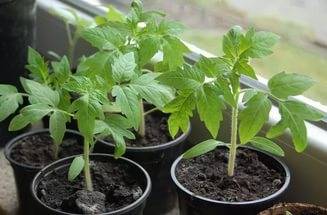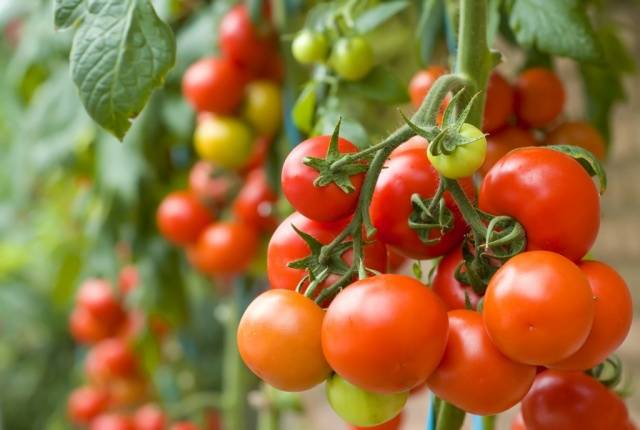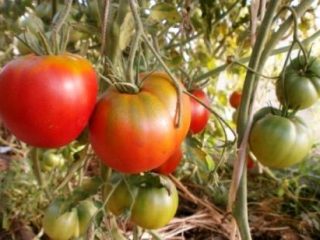Content
Despite the fact that tomatoes are heat-loving, many gardeners in Russia grow them outdoors. ground. For this purpose, special varieties and hybrids of tomatoes are chosen, which have a short period of fruit ripening and can successfully bear fruit even in rainy and cool summer weather. Growing Growing tomatoes in open ground also requires compliance with a certain technology that will allow you to obtain maximum crop yield and prevent the development of various diseases. Detailed description of all the nuances growing tomatoes in open ground, as well as current photos and videos are given below in the article. Having studied the proposed material, even a novice gardener will be able to grow a lot of tasty and healthy vegetables without the use of shelters.
Spring chores
The success of growing tomatoes in open ground largely depends on how carefully the soil and tomato seedlings were prepared in the spring. With the arrival of warmer weather, the farmer needs to sow seeds and provide proper care for young plants to obtain high-quality planting material.Preparing the soil for tomatoes is also an important point, which will reduce the stress of seedlings after planting and speed up the rooting process.
Variety selection
In open ground, you can grow both low-growing tomatoes and medium-sized and tall varieties. The technology for growing tomatoes of these types will be slightly different, however, in general, the cultivation rules are the same and apply to all varieties of tomatoes.
Early and mid-ripening hybrids and varieties are excellent for open ground. Among them are a number of the best tomatoes depending on the tallness of the plant:
- good tall tomatoes for open ground are “President”, “Mikado pink”, “Tolstoy f1”, “De barao royal”;
- among medium-sized tomatoes, the sales leaders are “Izobilny f1”, “Atlasny”, “Krona”, Kyiv 139”;
- When choosing low-growing tomatoes, you need to pay attention to the varieties “Lakomka”, “Moment”, “Amursky Stamb”.
An overview of other tomato varieties for open ground is shown in the video:
Tomato seedlings for open ground
In open ground in Russia, it is customary to grow tomatoes only in seedlings. This technology allows plants with a long growing season to be grown in a short period of warm summer. Considering the climate of central Russia, it should be said that tomato seedlings can be planted in open ground only in early June, when there is no chance of frost. Based on this, the gardener must draw up a schedule for growing seedlings, calculated taking into account the ripening time of the fruits of a particular variety. For example, the widely known and beloved indeterminate tomato variety "President" begins to bear fruit only 70-80 days from the day the seedlings appear. This means that it is necessary to sow tomato seeds of this variety for seedlings in mid-April and plant already grown tomatoes in the ground at the age of 40-50 days.
Before sowing tomato seeds for seedlings, it would be useful to harden them, warm them up and treat them with antiseptic substances:
- Warming makes tomatoes resistant to drought. To carry out the procedure, tomato seeds are suspended from a heating radiator in a fabric bag for 1-1.5 months in advance of all other treatments.
- Hardening of tomatoes is carried out using the variable temperature method, placing the seeds in a damp piece of cloth in the refrigerator for 12 hours. After cooling, the seeds are warmed at a temperature of +20-+220C for several hours, after which the seeds are again placed in the refrigerator. Hardening should be continued for 5-7 days. This measure will make the tomatoes resistant to low summer temperatures and possible frosts.
- Open ground conditions suggest possible infection of plants by various viruses, fungi and bacteria. Harmful microflora may be on the surface of tomato seeds. To destroy it, before sowing, tomato seeds are treated with a 1% manganese solution for 30-40 minutes.
Healthy seedlings are the key to obtaining a good harvest in unprotected conditions. To grow it, young tomatoes need to be regularly watered and fed, and provided with the necessary light regime by illumination.
At the early stage of growing tomato seedlings, it is necessary to use fertilizers with a significant nitrogen content.Before picking (2-3 weeks after seed germination) and planting seedlings in unprotected soil, it is necessary to use substances with large amounts of phosphorus and potassium. This will allow the tomatoes to quickly take root in new conditions.
Open ground conditions are characterized by unstable atmospheric temperatures and solar activity, which can damage the leaves of young plants. Before planting tomatoes in open ground, seedlings need to be adapted to such conditions by hardening. The event is being carried out gradually.
First, in the room where the seedlings are growing, you need to open a window or window for a while to ventilate the room and slightly lower the temperature in it. The next hardening step is to take the seedlings outside. The period of stay of plants in the open air should be gradually increased from 10-15 minutes to full daylight. In this mode, tomato leaves will be able to get used to the scorching rays of the sun and fluctuating temperatures. After planting in open ground, hardened tomatoes will not slow down their growth and will not get burned.
Planting seedlings is an important point
You can prepare the soil in the garden for growing tomatoes in the fall or immediately before planting tomatoes in the spring. To do this, add rotted manure, humus or compost to the soil in an amount of 4-6 kg for every 1 m2. The amount of fertilizer can be changed depending on the initial soil fertility. Organic fertilizer will add the necessary amount of nitrogen to the soil, which will activate the growth of tomatoes.This microelement must be supplemented with other equally important minerals: phosphorus and potassium. To do this, superphosphate and potassium sulfate are added to the soil in the spring.
It is advisable to plant seedlings grown in open ground in the place where legumes, radishes, cabbage, cucumbers or eggplants previously grew. The plot of land should be well lit by the sun and protected from drafts and north winds.
The scheme for planting seedlings in open ground may be different. Distances between tomatoes depend on the tallness of the bushes. Thus, two schemes for planting tomatoes in open ground are most often used:
- The strip-cluster checkerboard pattern involves dividing the site into ridges. The distance between two adjacent furrows should be about 130-140 cm. Tomatoes are planted on the resulting ridge in two rows (ribbons) at a distance of 75-80 cm in a checkerboard pattern. The holes on one tape are located no closer than 60 cm from each other. Two tomato bushes are planted in each hole or so-called nest at once, which makes it easier to garter the plants.
- The strip-nested parallel scheme also involves the creation of ridges and furrows between them. The difference between this scheme is the placement of tomatoes on strips parallel to each other. In this case, the distance between the holes can be reduced to 30 cm. 1 tomato is planted in each hole, thereby obtaining squares.
You can see a clear example of placing tomatoes in open ground according to the described schemes below.
It is better to plant tomato seedlings in open areas of land in the evening after sunset.A day before planting, the seedlings need to be watered with warm water; the soil on the ridges should be watered after creating the planting holes. If you follow the soil preparation rules after planting, tomato seedlings will feel vigorous, will not wither and will not significantly slow down their growth. In this case, for two weeks after planting, tomatoes in open ground do not require special care. They only need watering.
Basic rules for growing tomatoes in open ground
The technology for growing tomatoes in open ground involves performing a whole range of different activities. Tomatoes need not only to be watered and fed, but also tomato bushes to be formed, tied up, and regularly inspected for pests and diseases. Let's talk in detail about the rules for caring for tomatoes.
Watering plants
Tomatoes in open ground should be watered as needed with warm water. So, in the absence of rain, tomatoes need to be watered every 2-3 days. Tomatoes need to be watered at the roots in large quantities. Drops of moisture on the plant trunk and leaves are undesirable, as it can provoke the development of fungal diseases.
It is not at all advisable to grow tomatoes in areas with high groundwater or in marshy areas of soil, as this can lead to the development of a fungal disease - blackleg. This tomato disease can also develop when artificial watering of plants is carried out very often, “flooding” the roots of the tomatoes.
Feeding tomatoes with minerals and organic matter
Delicious tomatoes cannot be grown in large quantities without fertilizers. Farmers actively use organic fertilizers and minerals.Organic matter, represented by manure or compost, is saturated with nitrogen. It can only be used to increase the green mass of tomatoes until flowering.
In the process of flower formation and fruit ripening, tomatoes require potassium and phosphorus. These minerals can be added using universal complex fertilizers or simple minerals, wood ash. A sufficient amount of potassium in the soil makes the taste of tomatoes richer and increases the amount of sugar and dry matter in vegetables. Microelements also accelerate the process of fruit formation and ripening. An approximate schedule for applying mineral fertilizers is given below.
When growing tomatoes in open ground, it is necessary to apply mineral and organic fertilizers at least 3 times per season. In addition to the usual organic matter (mullein, slurry, chicken droppings) and minerals, gardeners often use organomineral fertilizers and improvised means, such as yeast. Many farmers claim that the secrets of growing tomatoes lie in choosing the right fertilizers at each specific stage of the plant's growing season.
This type of feeding is recommended for use when micronutrient deficiency is observed.
Formation of bushes
The process of tomato formation in open ground directly depends on the tallness of the bushes. For low-growing tomatoes, simply removing the lower leaves is sufficient. The measure makes it possible to make plantings less dense and improve the natural circulation of air flows, preventing the development of fungal and viral diseases. Remove the lower leaves of the tomatoes to the nearest fruit cluster.The removal procedure is carried out once every 10-14 days, and 1-3 leaves are removed from the bushes at once.
A feature of low-growing standard tomatoes is the limited growth of the bush and the short period of fruiting on one shoot. You can extend the fruiting process of such tomatoes by forming bushes of 1-3 stems, leaving an appropriate number of stepsons.
Growing tall tomatoes in open ground should include the correct formation of bushes. It involves removing the shoots and lower leaves of the tomato bush. Closer to autumn, approximately a month before the onset of frost, the top of the main stem must be pinched, which will allow existing tomatoes to ripen quickly. Growing tall tomatoes in open ground, in addition to careful shaping, requires some additional nuances, which you can learn from the video:
Gartering tall tomatoes in open ground is made difficult by the fact that the main shoot of an indeterminate variety can grow above 3 m. In this case, the shoot is tied to a high trellis and as soon as the tomato becomes higher than the support, it is pinched, leaving the stepson located in the middle of the bush as the main stem .
Due to difficulties with staking and formation, many gardeners refuse to grow tall tomatoes in open ground, since indeterminate varieties with an unlimited fruiting period do not have time to produce the full harvest in a short warm period. In this case, the greenhouse is able to maintain favorable conditions for such tomatoes much longer, increasing their productivity.
Protection against diseases
Growing tomatoes and caring for them in open ground is complicated by the fact that the plants are not protected from the vagaries of the weather. With the onset of low temperatures and high air humidity, you should be wary of tomatoes becoming infected with various fungal and viral diseases. They can damage plants and fruits, reducing crop yields or destroying them completely.
The most common fungal disease in open ground is late blight. Its fungi are carried by wind and water droplets. Getting on tomato wounds, the fungus causes blackening and drying of leaves and trunks, and the appearance of black, dense spots on the surface of the fruit. Late blight and other diseases can be combated using preventive measures. For example, spraying bushes with a whey solution once every 10 days will reliably protect tomatoes from fungus and will not cause damage to the quality of ripening tomatoes. Among the chemical preparations, Fitosporin and Famoxadone are highly effective against late blight fungus.
In addition to late blight, other diseases can develop in open areas of soil, the main prevention of which is compliance with the rules for forming a bush, watering and fertilizing. When tomatoes are infected with various diseases, it is necessary to take measures to treat them and, if necessary, remove plants from the beds. In the new year, before planting other crops in this place, it will be necessary to disinfect the soil by heating it over an open fire or watering it with boiling water or a manganese solution.
The main secret of growing tomatoes is to carefully and regularly inspect the plants. Only in this case can signs of any disease and pest exposure be detected in a timely manner.Monitoring the condition of tomatoes also allows you to identify symptoms of nutrient deficiency and the need for feeding at an early stage.
Conclusion
Thus, growing tomatoes in open ground requires a lot of care and attention from the gardener. Only by properly caring for plants can you get a decent harvest of vegetables. Regular feeding, proper watering of tomatoes and the formation of bushes allows plants to develop harmoniously and direct their energies to the formation and ripening of tomatoes. In turn, tomatoes with strong immunity are able to independently resist some pests and diseases. A video of growing tomatoes outdoors can also be seen here:























